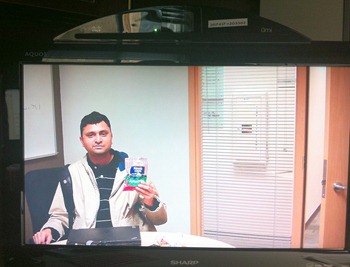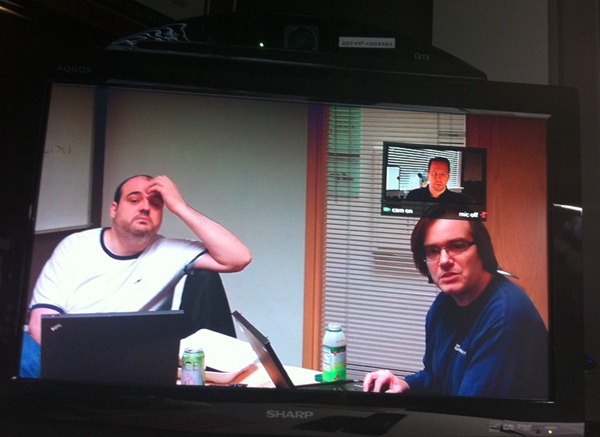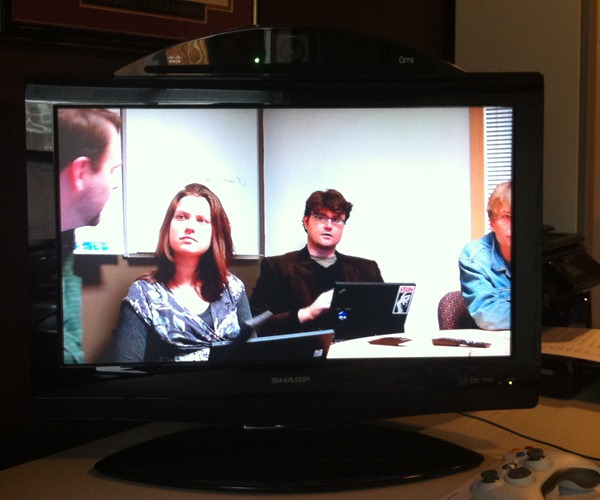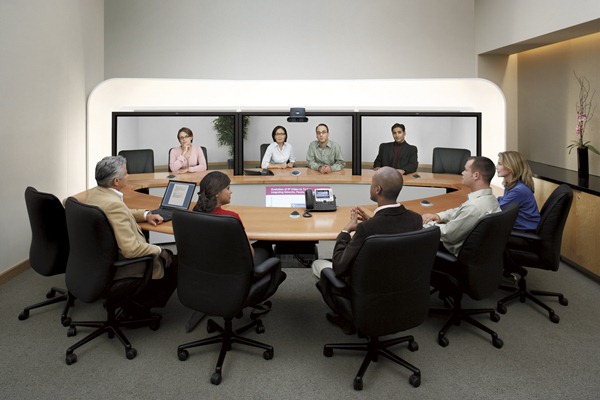 The picture at right is of my Cisco Umi I have hooked up at my house in Portland, OR. My friend Vishal is in Seattle. Why is he holding a bag of chips? More on that later.
The picture at right is of my Cisco Umi I have hooked up at my house in Portland, OR. My friend Vishal is in Seattle. Why is he holding a bag of chips? More on that later.
I noticed recently that I've now got a LOT of posts in my Remote Work category of my blog. Considering that I work for Microsoft in Seattle but from Portland and I have for three years now, I can say I'm officially a "Working Remotely Expert."
Important Point
There's some reviews out of the Cisco Umi (you-me) on the usual gadget blogs. They are lovely reviews by technical writers, to be clear. However, the folks that are writing these reviews don't need the product. They are smart technical product folks. However, I'm a practical pragmatist with a problem (alliteration not intended). I need to connect with my workplace without moving. Otherwise, I'll need to quit because I'm not moving. I need this product or one like it.
Let those reviewers argue about the marketplace. I'm using this thing every day and living it.
First, the background
I'm always looking for the next better way to work remotely, and let me tell you, it's not LiveMeeting or GotoMeeting. Being successful while working remotely is as much about the psychology of the situation as it is about the technology. Ultimately you have to realize that you're NOT there. Whether you're controlling a robot remotely and haunting the halls, or you've worked remotely for years as simply a voice on the conference line, you're not there.
Of course, as they say "out of sight, out of mind." The most important aspect of being remote is simply reminding folks that you exist. Sure, you can send emails and make sure you tell all the right people about what you're working on - and that's important - but there's something to be said for being present.
Many leadership and motivational speakers say "step 1 is showing up." I've written a number of posts on my experiments as a remote working attempting to show up.
- Hanselminutes Podcast 242 - The Plight of the Remote Worker with Pete Brown
- A frank conversation with another remote worker on the other side of the country. We air our grievances with folks who are seemingly unable to setup a video camera, and talk about the loneliness associated working from home.
- 30 Tips for Successful Communication as a Remote Worker
- Specific tips and practical techniques to communicate effectively as a remote.
- DIY: Making a Very Wide Angle Webcam on the Cheap
- $3 will get you a better (or at least, wider) view on things
- Building an Embodied Social Proxy or Crazy Webcam Remote Cart Thing
- You're not there and you take up no physical space. What if you did?
- Review and Comparison: Microsoft LifeCam Cinema HD and VX-7000 with High Quality Video in Skype and Live Messenger
- Pick the best camera for your video calls. I switch between a LifeCam and an HD Logitech now.
- How to Collaborate with Remote Employees with Office Communicator 2007 R2
- Forward this how-to to your bosses and their assistants.
- Virtual Camaraderie - A Persistent Video "Portal" for the Remote Worker
- What if you made a Skype video call and never hung up? Create a Portal between to locations to feel more connected.
- Working Remotely from Home, Telepresence and Video Conferencing: One Year Later
- A retrospective of my first year of remoteness.
- Skyping the Wife: Foolproof Video Conferencing with Your Family While on the Road
- Setting up auto-answer for spouses and bosses so they don't have to press buttons.
Now, the Review
It's insane. Experiencing Full HD 1080p 30fps video of your friends and co-workers is the closest thing a Portal I can imagine. First, the clarity. Most video calls are 640x480. 480p is about a third of a mexapixel or 307,200 pixels and 1080p is 2,073,600 pixels. That's 6 times more pixels on the screen. That's the equivalent of thirty 2-megapixel camera photos a second. The distance between 480p and 1080p can't be accurately expressed when you use numbers like 480 and 1080. This clarity issue can't be overstated. Believe me. If you look, there's artifacting, sure, but no more than a Blu-Ray.
In fact, I'd say that a Cisco Umi call is basically a live streaming Blu-Ray of your family.
Next, smoothness of motion or frames per second. Not only is it basically 6 times clearer than your average video call, it's also has twice as many frames. It's smoothness also can't be overstated. This was the first thing that Damian Edwards noticed when we hooked it up in his living room. It's so smooth that you stop thinking about it the way you do in a webcam. You may not realize it but you expect webcams to look like crap. You expect them to drop frames and feel jerky. That's because life happens as a greater framerate than that. ;) The Umi does a great job of keeping up with the framerate.
There's an HDMI pass-through on the Umi, which came as a welcome surprise to me as I have it in my home office. However, considering that this is a consumer (or pro-sumer) product that's meant for the living room, this is a smart move. You plug the Umi in as the last device before your TV. This means you can get calls when you're watching TV and the Umi "cloverleaf" interface will pop up and allow you to answer the call. For me, this meant I could keep my Xbox and Umi on the same HDMI input on my TV. If I'm playing Xbox I can still answer a Umi call.
The Cisco Umi interface is spartan in look, speed and style. In fact, to call it spartan my be unfair to the Spartans. It's basic to a fault. It's dry and uninspired. Fortunately as soon as the call starts you don't look at it again. Oddly, while the video runs at a buttery smooth 30fps, the user interface for the Umi feels very 10fps, you know? It feels underpowered and pokey. However, this is a nit as you only see it doing setup, answering and adding contacts. Both the UI and the Cisco Umi website are surprising in their lack of polish, but this isn't a deal breaker. A designer (maybe from the Xbox or PS3 teams) and a nice visual refresh of the admin website would really make a huge difference in the overall fit and finish.
Current Version: Chips and Audio Issues
Why's my buddy holding up chips? Well, there's an audio issue in the current version of the Umi. In some rooms with some TVs (not all, as I've seen it work fine in other situations) the Umi is a little aggressive with the audio noise cancelling. In an attempt to prevent feedback, the Umi software "clips audio" when two people talk at once on different sides of the call. That means if I Vishal says something or crinkles his bag of chips suddenly he can't hear me talk. Like, literally the sound is cut off completely.
It works fine if we take turns, but life isn't that convenient. People interrupt and talk over each other. Am I being too harsh? No. When was the last time you had your conference speakerphone or Skype cut someone off or mute them? Never, because it doesn't happen. Skype is absolutely brilliant with this.
Fortunately I have it on good authority from some very cool and very responsive Cisco Umi support guys that the engineers know about this audio edge case and are on it. My Umi auto-updated itself the first time I plugged it in, and I'm hoping that one day in the next few months this problem will just be solved. I'll update this post when that happens.
It's unfortunate because the Cisco Umi is supposed to have this amazing array microphone that is smart about picking up sounds and from my (and my team's) perspective, it's no better than a speaker phone, and in most cases much worse.
For now, this audio issue - in my room, given my constraints of very free-flowing conversations - is so irritating that we call the Umi then mute the audio. Then I'll use another audio channel (OC, Speaker Phone, whatever) as the audio. This works near-perfectly, and as an individual in a home office allows me also to use headphones. It'd be nice if there was an hardware option to plug in a standard USB microphone/headset into the UMI.
Rude Q&A
Here's my answers to a few of your questions.
Q. What, Skype HD to good for you? Live Messenger? Oovoo? Office Communicator/Lync?
A. Skype is stingy about HD video. They have been for four years. Four. You used to be able to hack it (I know, because I did) but currently there appears to be a white-list of supported cameras, specifically Logitech ones. There's obviously some kind of deal going on where they don't want to allow it for anyone on any camera can has the ability. A few technical points first. Pushing HD video is hard. Cameras like the LifeCam and other HD webcams can't push 1080p 30fps through USB2. Also, there are both driver issues and hardware issues. You can use the default driver that includes some filtering, color stuff, and animated fish nonsense, or you can use a default driver that just pushes out MJPEG (Motion JPEG) as fast as possible, unfiltered. In order to get 720p 15fps (yes, 15) you'll need at LEAST a quad-core processor to squish the frames as well as at least 1.5Mbps of bandwidth. Also note that you're not actually sending or receiving HD until the receiver's video window has expended to a size that is near 1280x720p. (This is a clever optimization.)
That was a lot of info. Here's the bullets:
- HD Video takes a LOT of CPU
- HD Video from today's USB cameras has a limited framerate when paired with today's software. We need more cameras with hardware acceleration or the ability for my video card to help out
- Believe it or not, 720p at 15fps isn't that great given the inexpensive sensors in today's cameras (and I've tried them all.) Once you've done a video call at 1080p at 30fps, it's hard to imagine anything else others than MOAR PIXELS!!!
Q. Isn't $600 per Umi expensive?
A. Sure. And so is a ticket. Or mileage, or a hotel. It's effectively $1000 for me to drive to Seattle, stay a few days, eat, submit a standard mileage expense and drive back. This whole system is about the same as one trip, except I use it daily.
I've said before, spend money and don't feel bad about it when it's something you use every day. Computer, Monitor, Bed, Chair, Car, Food. But the best quality in all these things. The Umi was a bargain. If I had relatives with decent bandwidth who lived more than 4 hours away I'd spend the money in a heartbeat so they could see my kids.
That said, there's a "Buy One Get One Free" Cisco Umi sale going on right now at BestBuy and Magnolia. So that's $600 all up for two, plus the fees. If your parents are far away and have 3 to 4Mbps of bandwidth to spare, that's a hell of a deal. This is over the 13th. Note, this is NOT an affiliate link and I don't get any money for any of this. I'm not attached to Cisco at all.
Q. What about the $25 per side monthly fee?
Ya, that is lame. It's the Umi tax. They have a cloud with support for visual voice mail, routing video calls to Google Chat, email notification, etc. I think $50 a year would be more reasonable.
Conclusion
You know those multi-thousand dollar telepresence rooms that you wish you had at your company? Well, I've got a tiny one and I'm 90% happy with it. I'm looking forward to the sound fixes. More as it comes!
Hope this was helpful. If you have an Umi, call me sometime at 207417.
© 2011 Scott Hanselman. All rights reserved.



